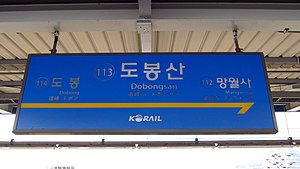
Uijeongbu is a city in Gyeonggi Province, South Korea.

Seoul Subway Line 7 of the Seoul Metropolitan Subway was built from 1990 to 1996 and was completed on August 1, 2000 ; the western section between Sinpung and Onsu was put into service on February 29, 2000. This north-south line does not run through the city centre but links Gangnam directly to the northeastern districts of Seoul. In 2019, Line 7 had an annual ridership of 380 million or 1.04 million passengers per day. Although most trains run between Jangam and Seongnam, some trains short turn at Onsu station and some trains start at Dobongsan station.
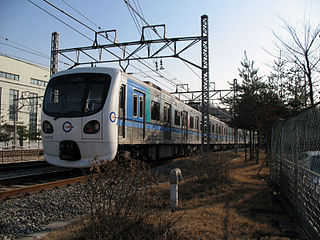
The Incheon Subway is a subway system serving the South Korean city of Incheon. The system is operated by Incheon Transit Corporation, and is part of the greater Seoul Metropolitan Subway.

Seoul Metropolitan Rapid Transit Corporation (SMRT) was established in 1994 to operate the Seoul Subway lines 5, 6, 7, 8 in Seoul, South Korea.

Incheon Subway Line 1 is a 30.3-kilometer (18.8 mi) north-south subway line, part of the Incheon Subway system. The line is also included as a part of the overall Seoul Metropolitan Subway network; Bupyeong Station has a free transfer with Seoul Subway Line 1, Gyeyang Station connects with the AREX Line which leads to Incheon International Airport and Seoul Station, Bupyeong-gu Office Station has a free transfer with Seoul Subway Line 7, and Woninjae Station has a free transfer with the Suin-Bundang Line.

Seoul Subway Line 9, operated by Seoul Line9 Operation, is a subway line in Seoul, part of the Seoul Metropolitan Subway. The line runs east from Gaehwa station or Gimpo International Airport station along the south bank of the Han River towards VHS Medical Center in Gangdong. In 2019, Line 9 had an annual ridership of 225 million or about 616,000 people per day.
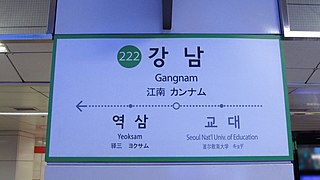
Gangnam is a station on Line 2 of the Seoul Metropolitan Subway. The station is located within the Greater Gangnam Area between the Gangnam and Seocho Districts of Seoul, South Korea. The station is the busiest station on the Seoul Metropolitan Subway, serving over 70,000 daily passengers on average.

Jongno 3(sam)-ga Station is an underground station on lines 1, 3 and 5 of the Seoul Subway in South Korea.

Cheongnyangni Station (Korean: 청량리역) is a major railway station located at Dongdaemun-gu, Seoul, South Korea. It serves as a terminus for passenger trains serving the eastern part of South Korea. KTX, ITX-Cheongchun, and Mugunghwa-ho trains terminates or stops at this station. Several Seoul Metropolitan Subway lines serve the station. These are: Seoul Subway Line 1, the Gyeongchun Line, the Suin–Bundang Line and the Gyeongui–Jungang Line.
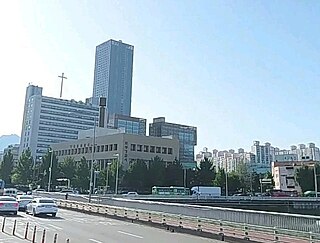
Dobong District is one of the 25 districts of Seoul, South Korea. As of 2020, Dobong has a population of 315,979 and an area of 20.71 square kilometres (8.00 sq mi), and is divided into four administrative neighborhoods. The district is located in northeastern Seoul, bordering the Gyeonggi Province cities of Yangju and Uijeongbu to the north, and the districts of Gangbuk to the southwest and Nowon to the east.
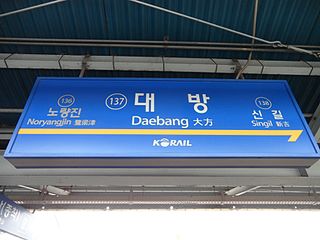
Daebang Station (Korean: 대방역) is a train station in Seoul, South Korea, and is also a stop on the Seoul Subway Line 1 and the Sillim Line. Before the opening of Line 5, this station served as the main link between the Seoul Metropolitan Subway system and Yeouido, a prominent business district in Seoul. Other places of interest in the vicinity of the station include Noryangjin Park and the Seoul Military Manpower Office, although the latter is closer to Boramae Station on Line 7.

Namyeong station is a ground-level metro station on Seoul Subway Line 1 in Galwol Dong, Yongsan-gu, Seoul, South Korea. Subways of Line 1 move on Gyeongbu Line from this station. The station's sole exit offers access to a range of schools and Yongsan Railway Office. Travel time from Namyeong Station to Incheon on Line 1 is 65 minutes.

Dongdaemun station is a station on Line 1 and Line 4 of the Seoul Metropolitan Subway. Sometimes called Dong Station, it is named after one of the Four Great Gates of the circular wall surrounding ancient Seoul, and is situated on the eastern end of Jongno. This station is also close to Dongdaemun Market.

Hoegi Station is a station on Seoul Subway Line 1, the Gyeongchun Line and the Gyeongui–Jungang Line. The two island platforms are side-by-side with each other, and are connected by an overpass. This is the closest station to Kyung Hee University, located northwest of here.

Uijeongbu Station is a station on the Gyeongwon Line in South Korea. It is also served by trains on Seoul Subway Line 1.

Wolgye Station is a metro station on Seoul Subway Line 1. In the northern part of the city, it lies on the line connecting Seoul's city centre with the cities to the north in Gyeonggi-do.

Kwangwoon University station is a train station on Seoul Subway Line 1, Gyeongchun Line and Gyeongwon Line in Seoul, South Korea operated by Korail. Together with Incheon station and Suwon station, this station was one of the three termini of Line 1 when it opened in 1974. Seongbuk Depot, one of the five depots of Line 1, is located nearby.
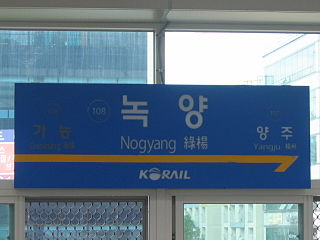
Nogyang Station is a station on the Gyeongwon Line in South Korea. It is served by Seoul Subway Line 1. The station lies in the far northern end of Uijeongbu in Gyeonggi-do.

Yangju Station is a train station on Seoul Subway Line 1 and the Gyeongwon Line. The name comes from Yangju, the city where this station is located. Until December 2007, it was called Junae Station.

Incheon Subway Line 2 is a driverless, medium-capacity subway line running 29.2 km (18.1 mi) from Oryu-dong in Seo-gu to Incheon Grand Park, with 27 stations, part of the Incheon Subway system. The line is also included as a part of the overall Seoul Metropolitan Subway network; Juan station has a free transfer with Seoul Subway Line 1, Geomam station connects with the AREX Line to Incheon International Airport and Seoul Station, and Seongnam also has a free transfer with Seoul Subway Line 7.
